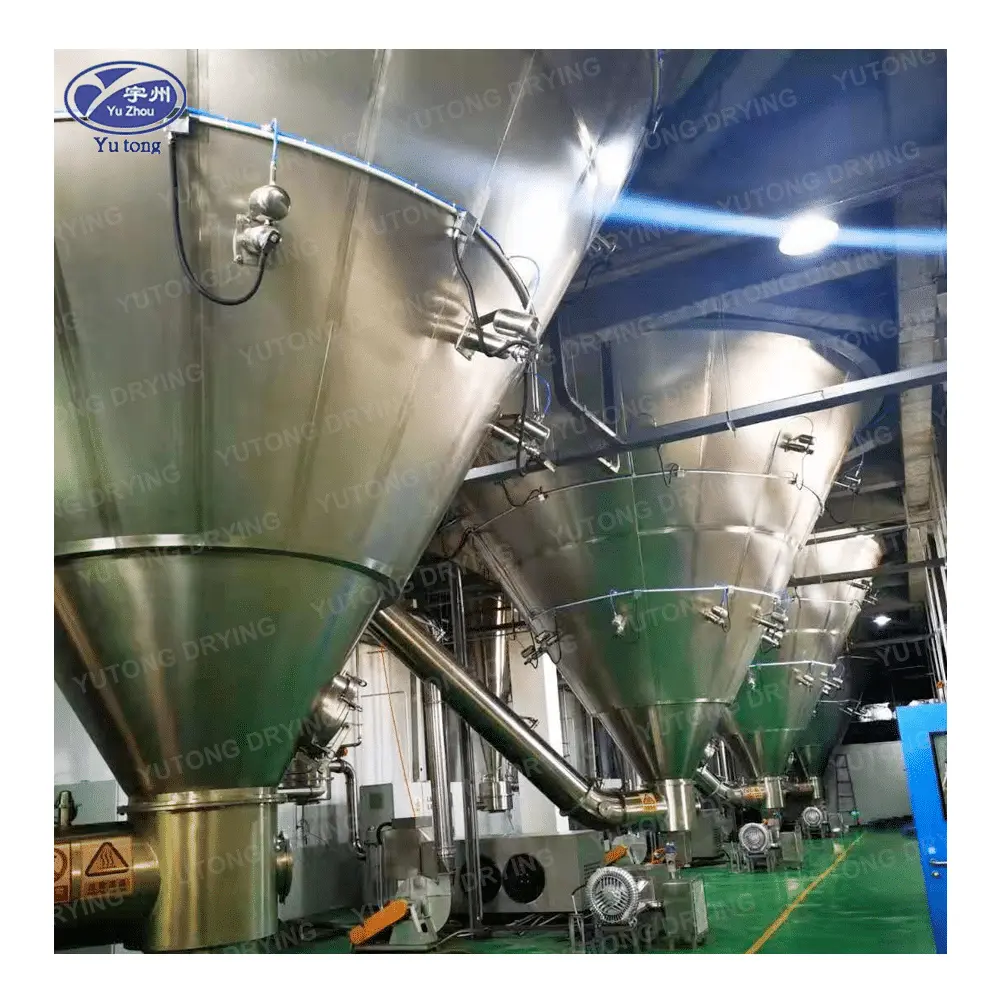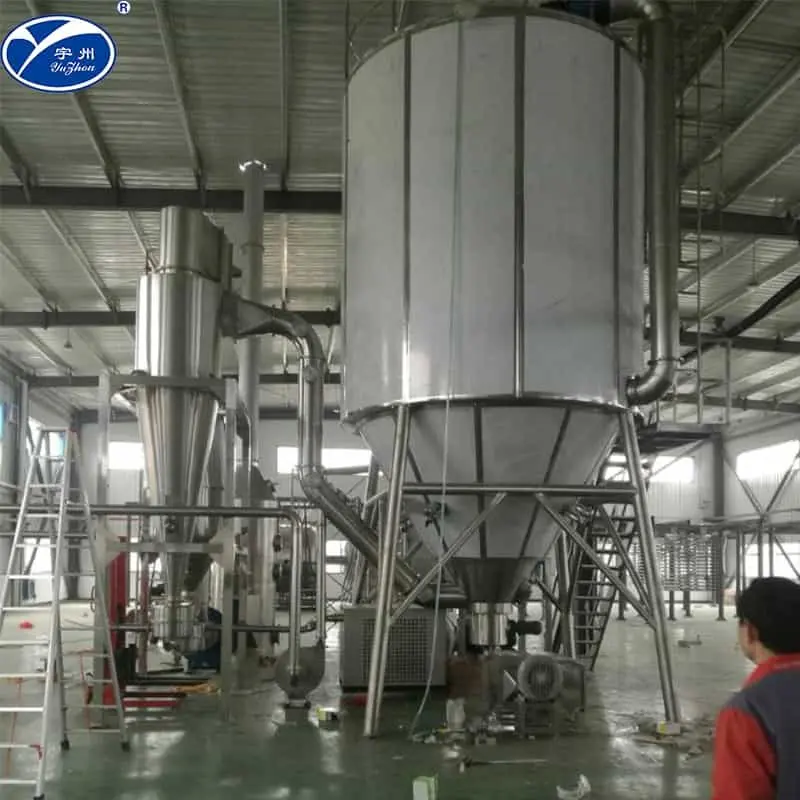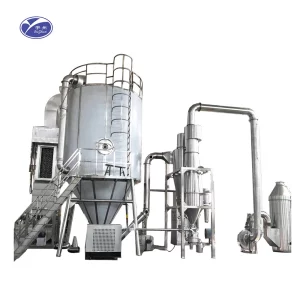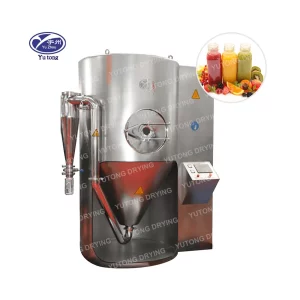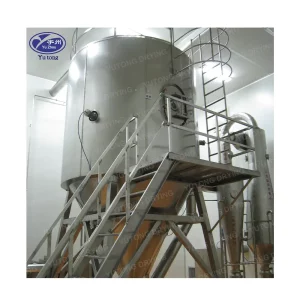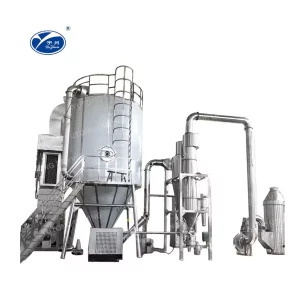Table of Contents
Product Detail
In the competitive landscape of detergent manufacturing, the production of high-quality detergent powder is crucial for satisfying consumer expectations and maintaining a competitive edge. Among the various methods employed for this purpose, the spray drying process stands out as one of the most efficient and widely adopted. This expanded article delves deeper into the role of spray dryers in creating detergent powder, highlighting the numerous benefits they offer and providing an in-depth explanation of their operation.
What is a Spray Dryer?
A spray dryer is a sophisticated piece of industrial equipment designed to convert a liquid mixture into a dry powder. This transformation is achieved by spraying the liquid into a chamber filled with hot air, which rapidly evaporates the moisture, leaving behind fine, dry particles. This process is particularly advantageous for detergent manufacturers, as it ensures uniform particle size and consistency in the final product.
The Fundamentals of Spray Drying
At its core, spray drying is a process that combines the principles of atomization and evaporation. The liquid mixture is broken down into fine droplets, which are then subjected to a stream of hot air. This rapid exposure to heat causes the moisture in the droplets to evaporate almost instantaneously, leaving behind solid particles.
Historical Context and Evolution
The concept of spray drying has evolved significantly since its inception. Initially developed for the food industry, the technology has been adapted and refined over the years to meet the specific demands of detergent manufacturing. This evolution has led to the development of advanced spray dryers that cater to the unique requirements of various industries.
Key Components of a Spray Dryer
A typical spray dryer consists of several key components: the feed pump, the atomizer or nozzle, the drying chamber, the air heater, and the cyclone separator. Each element plays a crucial role in the spray drying process, working together to ensure the efficient conversion of liquid slurry into dry powder.
Why Use a Spray Dryer for Detergent Powder?
The utilization of spray dryers in detergent powder production is favored for a multitude of reasons, each contributing to the overall efficiency and quality of the final product.
Consistent Quality
One of the primary advantages of using a spray dryer is the ability to produce detergent powder with uniform particle size and shape. This uniformity enhances the detergent’s solubility and performance, ensuring that it dissolves quickly and effectively during use.
Efficiency and Speed
Spray drying is a rapid process that can handle large volumes of liquid slurry, making it suitable for mass production. This efficiency allows manufacturers to meet high demand without compromising on quality or consistency.
Versatility in Formulation
Spray dryers are highly versatile and capable of processing a wide range of formulations. This adaptability makes them suitable for producing various types of detergents, including those for laundry, dishwashing, and other cleaning applications.
Hygienic Production
The closed system of a spray dryer minimizes the risk of contamination, ensuring that the detergent powder produced is of high purity. This is particularly important in maintaining the integrity and effectiveness of the detergent.
How Does a Spray Dryer Work?
Understanding the spray drying process provides valuable insight into its efficiency and effectiveness in producing detergent powders. Here’s a detailed step-by-step look at how a spray dryer operates:
Step 1: Preparing the Liquid Slurry
The process begins with the careful preparation of the liquid slurry, a mixture of detergent ingredients dissolved in water. This slurry includes surfactants, builders, enzymes, fragrances, and any other components necessary for the detergent formulation. The precise composition of the slurry is critical, as it determines the properties of the final detergent powder.
Step 2: Atomization
Once the slurry is prepared, it is pumped into the spray dryer, where it undergoes atomization. This involves breaking down the liquid into fine droplets using a nozzle or rotary atomizer. The atomization process significantly increases the surface area of the liquid, facilitating rapid drying and ensuring uniform particle size in the final product.
Step 3: Drying Chamber
The atomized droplets are introduced into a drying chamber filled with hot air. The temperature and airflow within the chamber are carefully controlled to ensure that the moisture in the droplets evaporates quickly without degrading the active ingredients. This precise control is crucial for maintaining the quality and effectiveness of the detergent.
Step 4: Powder Collection
As the moisture evaporates, the droplets transform into dry particles, which are collected at the bottom of the drying chamber. The dry detergent powder is then transported for further processing, such as sieving, blending, or packaging. This stage is essential for ensuring that the final product meets the desired specifications and quality standards.
Advantages of Using Spray Dryers in Detergent Production
Spray drying offers numerous advantages that make it the preferred method for producing detergent powders. These benefits contribute to the overall efficiency and quality of the production process.
Energy Efficiency
One key advantage of spray drying is its energy efficiency. The process consumes less energy than other drying methods, making it a cost-effective option for manufacturers. This efficiency is achieved through the rapid evaporation of moisture, which reduces the amount of energy required for drying.
Scalability and Flexibility
Spray dryers are highly scalable, allowing manufacturers to adjust production volumes according to demand. This flexibility is particularly beneficial for detergent producers, enabling them to respond quickly to market changes and consumer needs.
Product Stability and Preservation
The rapid drying process helps preserve the active ingredients in the detergent, ensuring that the final product remains effective over time. This stability is crucial for maintaining the performance and shelf life of the detergent powder.
Customization and Innovation
Manufacturers can easily adjust the slurry’s formulation to produce specialized detergent powders for different applications. This customization allows for the development of innovative products that cater to specific consumer preferences and requirements.
Innovations in Spray Drying Technology
Recent advancements in spray drying technology have further enhanced its application in detergent powder manufacturing, offering new possibilities for efficiency and quality improvement.
Energy Recovery Systems
Modern spray dryers are equipped with energy recovery systems that reduce operational costs by recycling heat. These systems capture and reuse the heat generated during the drying process, minimizing energy waste and enhancing overall efficiency.
Improved Atomization Techniques
Advances in atomization technology have led to the development of finer and more uniform particle sizes, improving the quality of the detergent powder. These improvements result in better solubility and performance, meeting consumers’ high expectations.
Automated Control Systems
State-of-the-art spray dryers incorporate automated control systems that monitor and adjust the drying process in real time. These systems ensure consistent product quality by maintaining precise control over temperature, airflow, and other critical parameters.
Choosing the Right Spray Dryer for Your Needs
Selecting the appropriate spray dryer is crucial for optimizing detergent production. Several factors should be considered to ensure the best fit for your manufacturing needs.
Capacity and Production Volume
It is essential to choose a spray dryer that can handle the desired production volume. This consideration ensures that the equipment can meet demand without compromising on efficiency or quality.
Material Compatibility and Durability
The materials used in the construction of the spray dryer should be compatible with the detergent formulation to prevent corrosion or contamination. Ensuring material durability is key to maintaining the equipment’s longevity and performance.
Ease of Maintenance and Operation
Opt for a spray dryer that is easy to clean and maintain. This will reduce downtime and operational costs. Simplified maintenance procedures also contribute to the overall efficiency and reliability of the production process.
Supplier Support and Service
Partner with a reputable supplier who offers technical support and after-sales service. Reliable supplier support is invaluable for addressing any issues that may arise and ensuring the smooth operation of the spray dryer.
Conclusion
The spray dryer is an indispensable tool in the production of high-quality detergent powders. Its efficiency, versatility, and ability to produce consistent results make it a preferred choice for manufacturers worldwide. By understanding the spray drying process and leveraging modern technological advancements, detergent producers can enhance their production capabilities and meet the ever-evolving demands of consumers. Whether you’re a small-scale manufacturer or a large industrial producer, incorporating a spray dryer into your production line can significantly improve the quality and efficiency of your detergent powders.
Specifications
|
spec
|
ZPG-25
|
ZPG-50
|
ZPG-80
|
ZPG-100
|
ZPG-150
|
ZPG-200
|
ZPG-300
|
|
|
evaporation capacity(kg/h)
|
25
|
50
|
80
|
100
|
150
|
200
|
300
|
|
|
process amount of material liquid(kg/h)
|
25-34
|
50-68
|
80-108
|
100-135
|
150-203
|
200-270
|
300-406
|
|
|
output of finished pcoduct(kg/h)
|
4.8-7.2
|
9.2-14
|
14.8-22.4
|
18.4-28
|
24-42
|
36.8-56.4
|
55-85
|
|
|
solid content of material liquid( %)
|
18-30
|
|||||||
|
moisture content of finished product( %)
|
3-5
|
|||||||
|
electric power(kw)
|
63
|
132
|
153
|
204
|
246
|
330
|
||
|
heat source
|
Steam pius electricity
|
|||||||
|
Collecting method of product and its efficiency
|
Grade one or two or three stage cyclone wet dust remover is greater than or equal to 95%
|
|||||||
|
automatic control meters and instruments
|
indicator of not air and exhaust air temperature
|
|||||||
|
temperature of air inlet(℃)
|
160-220
|
|||||||
|
temperature of air outlet(℃)
|
80-100
|
|||||||
|
L
|
7000
|
8000
|
9800
|
11000
|
12200
|
14100
|
15000
|
|
|
overal dimensions(mm)
|
W
|
4000
|
5000
|
5700
|
6200
|
7000
|
7800
|
9000
|
|
H
|
6200
|
6900
|
8000
|
8900
|
10750
|
11900
|
13000
|
|
Applications
Machinery Repair Shops: Can be used for drying lubricants, cleaning agents, or other liquid substances related to machinery maintenance and repair.
Food & Beverage Factory: Ideal for drying food ingredients like milk powder, fruit and vegetable powders, flavourings, etc., thanks to its hygienic construction and precise drying control.
Farms: Useful for drying agricultural products or by-products in certain processing scenarios.
Retail and Food Shop: May be employed for small-scale drying operations or demonstrations related to food products.
Construction works: Can handle the drying of certain construction materials or chemical admixtures.
Energy & Mining: Applicable for drying chemical reagents or samples in related processes.
Food & Beverage Shops: Similar to food factories, it can be used for in-shop drying of food items or custom blends.
Our industrial spray dryer is a versatile and reliable asset for multiple industries, offering efficient drying, long service life, and user-friendly operation. It is engineered to meet the highest standards of quality and performance, making it an ideal choice for any industrial drying application.

